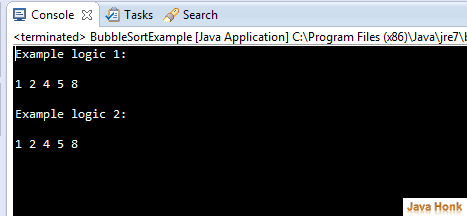Bubble sort, sometimes incorrectly referred to as sinking sort, is a simple sorting algorithm that works by repeatedly stepping through the list to be sorted, comparing each pair of adjacent items and swapping them if they are in the wrong order. The pass through the list is repeated until no swaps are needed, which indicates that the list is sorted.
Bubble sort algorithm gets its name from the way smaller elements “bubble” to the top of the list. Because it only uses comparisons to operate on elements, it is a comparison sort.
Although the algorithm is simple, most of the other sorting algorithms are more efficient for large lists.
bubble sort step-by-step example. Let us take the array of numbers “5 1 4 2 8”, and sort the array from lowest number to greatest number using bubble sort. In each step, elements written in bold are being compared. Three passes will be required.
Bubble Sort First Pass:
( 5 1 4 2 8 ) \to ( 1 5 4 2 8 ), Here, algorithm compares the first two elements, and swaps since 5 > 1.
( 1 5 4 2 8 ) \to ( 1 4 5 2 8 ), Swap since 5 > 4
( 1 4 5 2 8 ) \to ( 1 4 2 5 8 ), Swap since 5 > 2
( 1 4 2 5 8 ) \to ( 1 4 2 5 8 ), Now, since these elements are already in order (8 > 5), algorithm does not swap them.
Bubble Sort Second Pass:
( 1 4 2 5 8 ) \to ( 1 4 2 5 8 )
( 1 4 2 5 8 ) \to ( 1 2 4 5 8 ), Swap since 4 > 2
( 1 2 4 5 8 ) \to ( 1 2 4 5 8 )
( 1 2 4 5 8 ) \to ( 1 2 4 5 8 )
Now, the array is already sorted, but our algorithm does not know if it is completed. The algorithm needs one whole pass without any swap to know it is sorted.
Bubble Sort Third Pass:
( 1 2 4 5 8 ) \to ( 1 2 4 5 8 )
( 1 2 4 5 8 ) \to ( 1 2 4 5 8 )
( 1 2 4 5 8 ) \to ( 1 2 4 5 8 )
( 1 2 4 5 8 ) \to ( 1 2 4 5 8 )
Bubble Sort Implementation example using java:
package com.javahonk; public class BubbleSortExample { public static void main(String[] args) { int[] numbers = { 5, 1, 4, 2, 8 }; System.out.println("Example logic 1: \n"); numbers = BubbleSort(numbers); for (int i = 0; i < numbers.length; i++) { System.out.print(numbers[i] + " "); } System.out.println("\n\nExample logic 2: \n"); numbers = BubbleSortExample2(numbers); for (int i = 0; i < numbers.length; i++) { System.out.print(numbers[i] + " "); } } public static int[] BubbleSort(int[] num) { int temp; for (int i = 1; i < num.length; i++) { for (int j = 0; j < num.length - i; j++) { if (num[j] > num[j + 1]) { temp = num[j]; num[j] = num[j + 1]; num[j + 1] = temp; } } } return num; } private static int[] BubbleSortExample2(int[] num) { for (int i = 0; i < num.length; i++) { for (int x = 1; x < num.length - i; x++) { if (num[x - 1] > num[x]) { int temp = num[x - 1]; num[x - 1] = num[x]; num[x] = temp; } } } return num; } }
Output:
